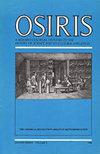Locating Kexue Xiangsheng (Science Crosstalk) in Relation to the Selective Tradition of Chinese Science Fiction
IF 1
3区 哲学
Q2 HISTORY & PHILOSOPHY OF SCIENCE
引用次数: 2
Abstract
Kexue xiangsheng (science crosstalk) features comic dialogues aimed at popularizing knowledge in the physical and social sciences. This genre emerged in the late 1950s in the People’s Republic of China (PRC) as part of a massive effort in the state-supervised culture industry to promote science. The genre shared many of the hallmarks of PRC instrumentalist science fiction, as both were based on a Soviet model. Authors and literary theorists like Guo Moruo, Ye Yonglie, and Gu Junzheng reiterated developmental narratives of socialism and of the power of science as a tool for mastery of nature developed by authors like Maxim Gorky and Mikhail Il’in. These works of socialist realism narrated transformations in the consciousness of their characters as they came to understand guiding principles of the world around them, including basic science, evolution, and dialectical materialism. Dramatic forms like kexue xiangsheng worked in concert with other socialist-realist representative modes, including popular performance, reportage, fiction, film, song, and reappropriations of premodern literary forms. In the process, notions of scientific thinking were conflated with political orthodoxy in promoting public health and political campaigns, and science was dismantled as a professional institution, shifting from a rationalized bureaucratic endeavor to grassroots efforts aimed at solving pragmatic problems. Through education in what I term the “quotidian utopian”—small health and hygiene measures that had the potential to ameliorate major health challenges—these popular science genres also straddled the line between Frederic Jameson’s “Utopian form and Utopian wish,” between what was part utopian text and part expression of the impulse to enact utopia through changes in policy and reconfigurations of the collective body.从中国科幻小说的选择传统看《科学相声》
科学相声以相声为特色,旨在普及物理和社会科学知识。这一流派出现在20世纪50年代末的中华人民共和国(PRC),是国家监管的文化产业促进科学发展的巨大努力的一部分。这一类型具有中国工具主义科幻小说的许多特征,因为两者都是以苏联模式为基础的。作家和文学理论家,如郭沫若、叶永烈和顾俊正,重申了马克西姆·高尔基和米哈伊尔·伊林等作家发展的社会主义和科学力量作为掌握自然的工具的发展叙事。这些社会主义现实主义作品讲述了他们的人物意识的转变,因为他们开始理解周围世界的指导原则,包括基础科学、进化论和辩证唯物主义。像柯学相生这样的戏剧形式与其他社会主义现实主义的代表模式相结合,包括通俗表演、报告文学、小说、电影、歌曲,以及对前现代文学形式的重新利用。在此过程中,在促进公共卫生和政治运动中,科学思维的概念与政治正统混为一谈,科学作为一个专业机构被拆除,从合理化的官僚努力转向旨在解决务实问题的基层努力。通过我称之为“日常乌托邦”的教育——有可能缓解重大健康挑战的小型健康和卫生措施——这些科普流派也跨越了弗雷德里克·詹姆森的“乌托邦形式和乌托邦愿望”之间的界限,部分是乌托邦文本,部分是通过改变政策和集体机构的重组。
本文章由计算机程序翻译,如有差异,请以英文原文为准。
求助全文
约1分钟内获得全文
求助全文
来源期刊

Osiris
管理科学-科学史与科学哲学
CiteScore
1.10
自引率
0.00%
发文量
18
审稿时长
>12 weeks
期刊介绍:
Founded in 1936 by George Sarton, and relaunched by the History of Science Society in 1985, Osiris is an annual thematic journal that highlights research on significant themes in the history of science. Recent volumes have included Scientific Masculinities, History of Science and the Emotions, and Data Histories.
 求助内容:
求助内容: 应助结果提醒方式:
应助结果提醒方式:


